When the Cascadia Sustainability Field School visited Vancouver (in May, 2014) we had a chance to reflect on the variety of ways “sustainability” is imagined.
Our first foray into the city was a downtown walking tour lead by well- known Vancouver urban superstar, former city counselor etc. Gord Price. For Gord, sustainability represented a formidable challenge for a city that was founded on movement (of goods, information and people) and the exploitation of resources. Vancouver, it could be said, was about exploiting the hell out of heaven.
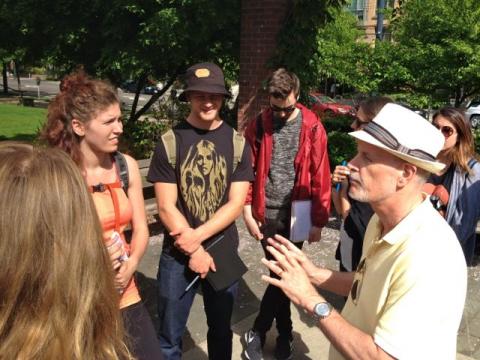
Gord Price chatting with students in a Yaletown Park.
But, in our grappling with “sustainability”, Gord wanted us to move beyond a fixation on the language of “limits” and indignation with “greedy developers”. Instead, he wanted us to look at the regulatory context – the insidious “rules” - within which development took place.
Gord’s main concern and interest in sustainability focused on efforts to constrain automobility to address climate change (not to mention building a more convivial city). Gord described climate change as a big, nasty gorilla that was more and more difficult to ignore.
For him, Vancouver was already as active as any city in working to attracting more people to live downtown – offering “density with amenity”. In turn these efforts were insidiously changing transportation habits, reducing greenhouse gas emissions and creating vibrant places Jane Jacobs might celebrate.
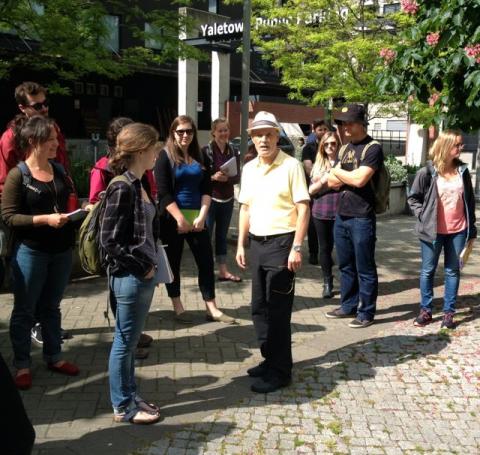
Traversing a pedestrian greenway that ran on top of an underground parking garage in Yaletown, Gord reasoned that developers could actually be made into allies pushing for changes to rules with respect to parking allotment for downtown developments. Developers don’t want to pay the millions of dollars to blast and to build such infrastructure. Without claiming to be “green” the emerging downtown work-live-play environment could shift (and empirically had shifted) behaviours around car ownership.
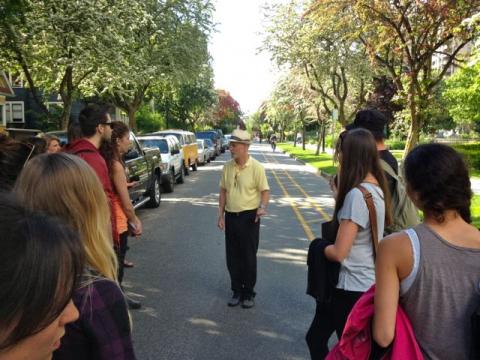
To demonstrate his point that dense downtown living had great benefits, Gord lectured to us on a quiet road in the West End where cyclists and pedestrians far outnumbered cars.
The next morning we met with UBC sustainability guru John Robinson for a tour of the Centre for Interactive Research in Sustainability – a celebrated green building on campus. Just like Gord, John argued that we (who want to see a more sustainable direction) should move away from focusing on limits, reducing, sacrificing and focus more on creative action that improves human and ecological well-being. John termed this approach – regenerative sustainability.
John’s vision of sustainability went far beyond reducing emissions and staving off climate change to a wide range of other ecological and social concerns. The hopes for the CIRS building were that it would end up being a net-positive development – actually contributing to ecological and social improvements rather than just being slightly less impactful than other buildings.
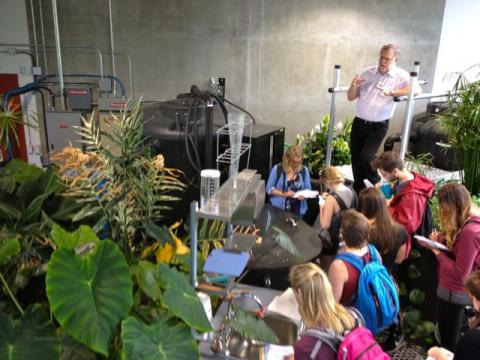
John Robinson showing us how the CIRS building makes a net-zero contribution for example using rainwater and treating all waste water on site.
Interestingly John observed that the biggest barriers to sustainability were not technological or even financial – but rather “institutional”. Like Gord, John pointed to insidious rules and entrenched institutional cultures as exerting enormous inertia against change. A beautiful green roof that seemed to invite a lovely outdoor patio space was sealed off because of health regulations surrounding human proximity to “irrigated” water. Regardless of whether or not it could be proven beyond any doubt that there were no water safety concerns, this regulation ensured the door would remain locked. The building was denied “Living Building” designation because it used beetle-kill wood instead of FSC-certified “sustainable” wood despite super important ecological benefits from using the former.
That afternoon we met with architect and local resident Richard Vallee who toured us around South False Creek. While much less sensationalized that the famed Southeast False Creek (Olympic Village) or the Concord Pacific development that sprawls along the northside of Vancouver’s inner bay – False Creek – this development is quietly regarded one of the most interesting in Vancouver.
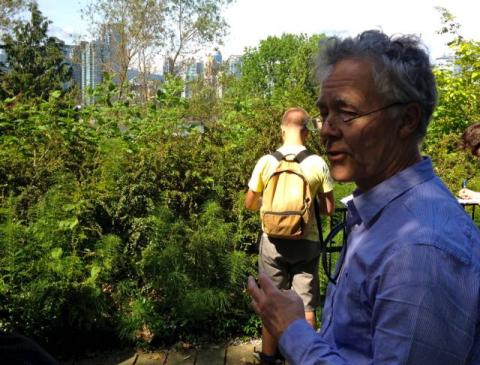
In proximity to Granville Island, the community boasts no soaring towers or shimmering glass and steel but provides a rich environment for folks of all incomes to enjoy waterfront living. Built around the beautiful, natural-feeling green space (that is actually completely contrived – i.e. built on reclaimed land) South False Creek has a school, a cooperative houseboat community and housing that is 1/3 market, 1/3 lower income rental and 1/3 coop housing. Conspicuously missing are cars – that had been relegated to the inland periphery of the development. With its commitment to housing fairness and inter-connection, perhaps nowhere else are the principles of Trudeau liberalism more readily apparent in the cultural landscape. Vallee was more reluctant to talk about “sustainability”, but he felt if we were to use the term we’d want to ensure we did not neglect the social, cultural element, Building vibrant places where people could connect (for example around a spontaneously BBQ & Beer) were the key ingredient.
While most agree that sustainability involves thinking about some kind of alignment of social, economic and ecological priorities, the concept remains anything but self-evident. Rather it is a conceptual terrain for imagining and re-imagining the future. We will keep adding to our thinking and rethinking sustainability as we continue our journey.

